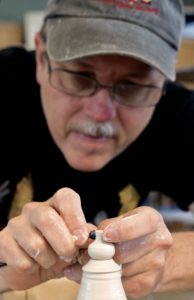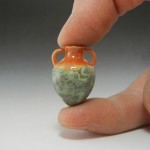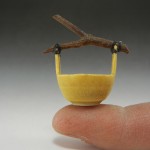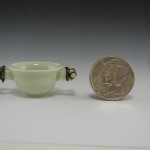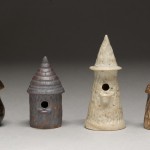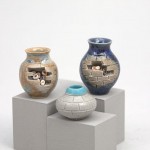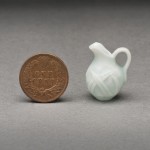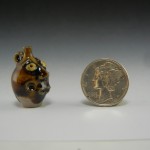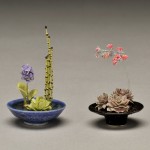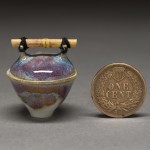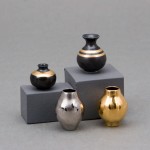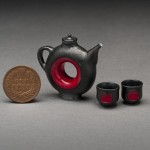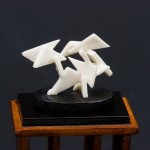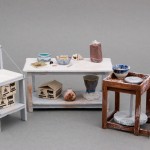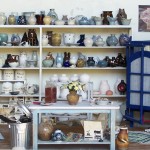1/12 Scale Wheel-Thrown Porcelain Miniatures
I am self-taught in the art of miniature pottery, having learned through practice and experimentation over the past twenty-five years. I began creating wheel-thrown pottery in one-inch-scale in 1993 (after I had already learned to make full-size pottery). Today I continue to create high quality replicas of historic ceramics as well as modern art for discerning collectors.
My goal is to create true to scale pottery that is aesthetically pleasing as well as “functional”: walls of even thickness, trimmed foot ring, open spouts, removable lids — the same qualities I look for in a large pot. In addition to making scale miniature pottery I also make ‘life-sized’ pottery and have taught ceramics in Santa Barbara since 1997.
I throw my pots on a full size potter’s wheel; none of them are cast or mass-produced by molds. The potter’s wheel that I use is the same wheel that I have used to make 50 pound bowls. The process of throwing miniatures is very much the same as throwing life-sized pottery except I contact the clay with my finger tips rather than my entire hand and all of the motion of my finger tips is contained within a volume not much greater that one cubic inch. This reservation of movement calls for a great deal of focus and patience. Over the years I have developed special tools and techniques to use in place of my fingers to draw up, open and shape vessels on the top of a hump of clay as well as methods of shaping and altering my pots once they are thrown. After forming my miniatures on a revolving mound of clay, they are allowed to dry until they can keep their form and then they are re-centered upside-down on the wheel and a foot ring is carved on the bottom; like their life-size counterparts — this attention to detail completes the piece.
I am a member of the International Guild of Miniature Artisans and was elevated to Fellow status in 1999. Today my miniatures are in collections around the world and have been featured in many magazines in the U.S. and Europe including Nutshell News, Dollhouse Miniatures, Miniature Collector, Dolls House World, Artisans In Miniature (AIM) Magazine, and Miniaturas.
Though I divide my time between making miniatures as well as life-size pottery, it is my miniatures that are the harder to make, require my absolute attention and test my patience but they are unequivocally the most rewarding and fulfilling thing I create as an artist.
To see my work in person at a gallery or miniature show – check my show Schedule. You can also see my press page for news articles. To view miniatures I am selling online check out my Online Store. For more photos – follow me on Instagram.
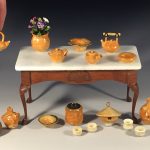
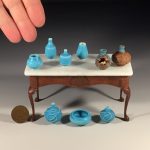
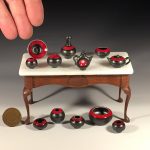
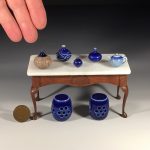
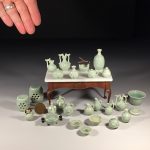
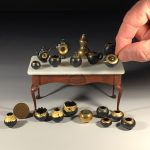
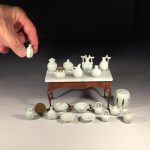
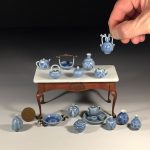
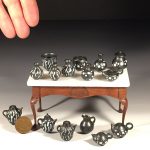
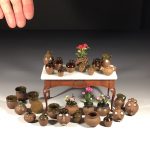
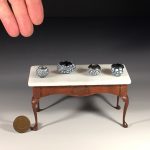
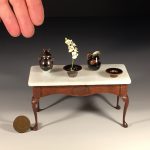
My goal is to create true to scale pottery that is aesthetically pleasing as well as “functional” — walls of even thickness, trimmed foot rings, open spouts, removable lids — the same qualities I look for in a large pot. I originally began making miniature ceramics in 1993 after l had already become proficient at throwing life-sized pottery; initially experimenting to see how small a cylinder I could throw and how thin I could pull up the walls. It proved to be an intriguing challenge and I came to realize that any form was possible in this scale — the challenge lay in determining how to best shape the clay at so small a scale. Within a couple of years I began selling my small scale artwork at miniature shows and I joined the International Guild of Miniature Artisans whose goal is to promote miniatures as a true art form. I juried into the I.G.M.A. as an Artisan in May 1996 and was elevated to Fellow status in March 1999. Today I divide my time between making miniatures and life-size pottery as well as teaching beginning pottery classes.
I throw my pots on a full size potter’s wheel or meticulously hand form vessels from slabs of clay; none of them are cast or mass produced by molds. The potter’s wheel that I use is the same wheel that I have used to make 50 pound bowls. The process of throwing miniatures is very much the same as throwing life-sized pottery except I contact the clay with my finger tips rather than my entire hand and all of the motion of my finger tips is contained within a volume not much greater that one cubic inch. This reservation of movement calls for a great deal of focus and patience. Over the years I have developed special tools and techniques to use in place of my fingers to draw up, open and shape vessels on the top of a hump of clay as well as methods of shaping and altering my pots once they are thrown. After forming my miniatures on a revolving mound of clay, they are allowed to dry until they can keep their form and then they are re-centered upside-down on the wheel and a foot ring is carved on the bottom; like their life-size counterparts — this attention to detail completes the piece.
I consider glaze application to be the most difficult aspect of creating scale miniature ceramics. I mix all of my glazes; some of them are the same glazes I use for my large pottery, others are glazes that I have modified or calculated exclusively for my miniatures and the porcelain that they are made from. If glazes are applied too thick they will run or clog spouts and handles, effectively changing the proportion of a piece, but if they are put on too thin they will lack their full potential and appear dull and lifeless. Once glazed, my miniatures are generally fired in gas kilns along side their full-size counterparts. I have fired my miniatures in electric and gas kilns, in oxidizing and reducing environments and to temperatures ranging from cone 018 (1314°F) to cone 10 (2340°F) including techniques such as luster, raku, salt and saggar.
In addition to making ceramic miniatures, I also make some art studio furniture and accessories (see “Dollhouse Miniatures” November 2001 cover & Artisan’s Showcase) and I occasionally make a room box for my own enjoyment or for commission, but my primary focus in miniatures is the high fired porcelain that I have become known for. However, I hope to do more work on structures in the future.
I primarily sell my miniatures at shows around the United States. The items I have in stock at any time will vary. If you are interested in something — let me know and I will send you a photo of what I have in stock. Each of my scale miniatures is individually hand crafted (none are molded or mass produced), so no two are exactly alike — they are all are one-of-a-kind.
~Troy~

